Good morning everyone, and welcome back to another edition of Marvel Masterpieces Parallels in Masterpiece Theater here on Hipsters of the Coast! I’m continuing my exploration of Upper Deck’s Marvel Masterpieces from 2016-2020, a continuation of my deep dive into the most recent Marvel Masterpieces 2020 set by Dave Palumbo. As I neared that series completion in 2021, I became curious about how Palumbo’s work would connect to the previous two “modern” Masterpiece sets that came before him. The 2016 set was done by Joe Jusko, artist of the first Marvel Masterpieces set in 1992. And in 2018, the hugely popular Italian comic artist Simone Bianchi followed in his footsteps, and completed his own Marvel Masterpieces set with new characters, new Battle Spectra scenes, and an entirely different stylistic take on the Marvel universe.
Each of the three sets are completely unique and puts an artist’s style in the full spotlight. Jusko’s look is classic comic book, with all the muscle, color, and vibrancy of the sets from the 1990s, but reimagined with nostalgia for a new century. Bianchi is more contemporary: darker and grittier with bold blacks and colored outlines to make his characters distinct and out of this world. Palumbo falls somewhere in the middle: his big brushstrokes give a painterly feel to the genre, and bring a balance to the modern Masterpieces. His rendition especially is something that trading cards have never seen.
Across the three sets 2016-2020, there are 42 characters that were painted into each set at least once, and several characters that have multiple appearances within a given year. In total we’ll look at more than 175 artworks throughout this series from each of the last three iterations of Marvel Masterpieces. We’ll compare and contrast each artist’s creation, and learn some pretty cool stuff directly from the artist’s themselves along the way. This series isn’t about picking the best work, but rather talking about why each is a Masterpiece in its own right, and how these works function as a family of premier illustrations both within and across their respective sets.
This article concludes our discussion in and around the Avengers, as we take a look at some of the baddest baddies the team has fought over the years. And for this article we’ll be going in straight chronology, 2016-2020, left to right. This is Parallels: Avengers Villains
Hela
Let’s get this started, and Ladies First of course. Our first villain is none other than the sister of Thor: it’s Hela, the goddess of Death.
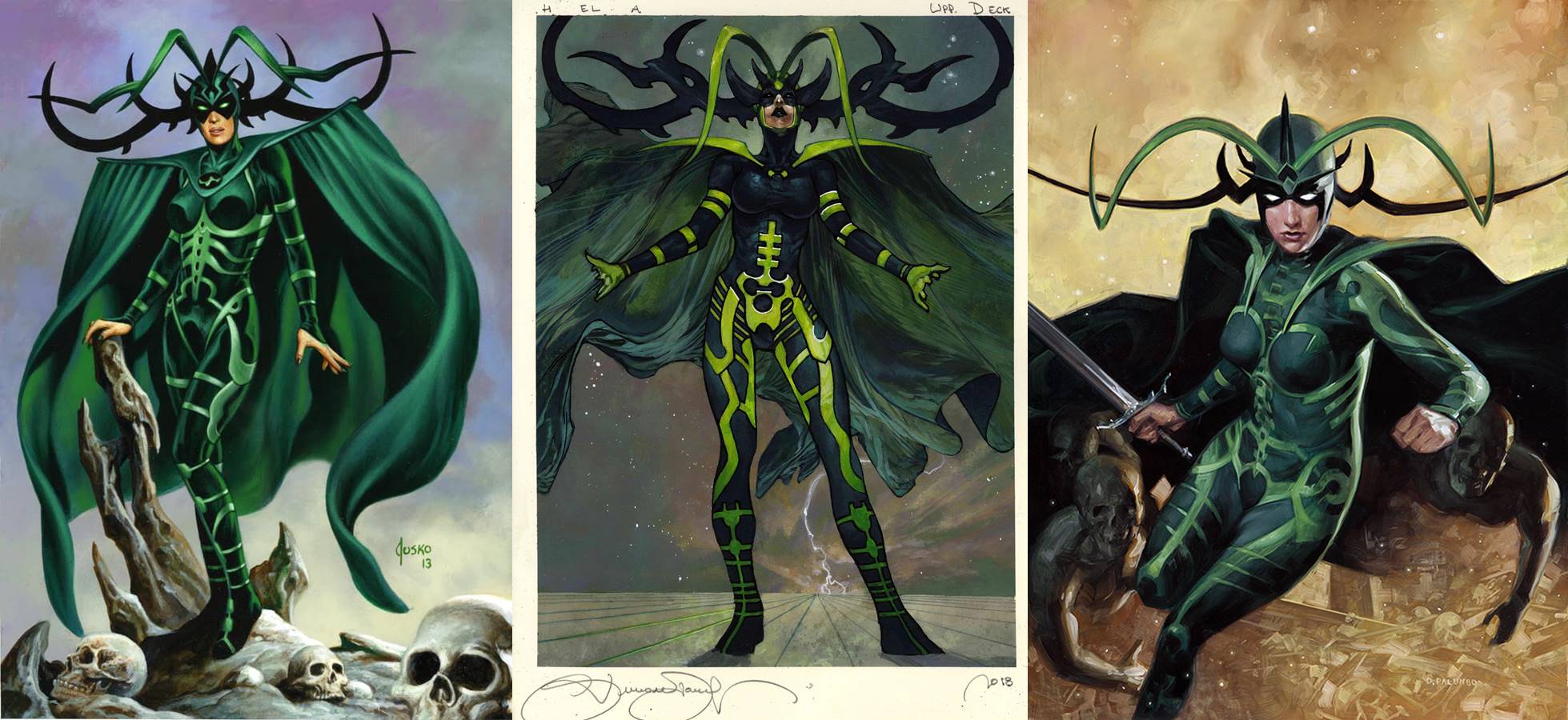
Left to Right: Hela by Joe Jusko, 2016; Hela by Simone Bianchi, 2018; Hela by Dave Palumbo, 2020.
In his book Jusko summed up Hela as well as I ever could: “regal, majestic, and foreboding.” Those are exactly the aesthetics we see across these three pieces. In each work she is unendingly poised against a backdrop of death and desolation.
In Jusko’s work, she stands atop skulls, but the slight lift to her right hand elevates her figure, as if she’s floating, perfectly prepared. In Bianchi’s painting we see that nuclear green once again, as he emphasizes the runes of her costume and provides incredibly otherworldly depth to the barren landscape we see disappear in the distance. And Palumbo has added some undead company to his depiction; she is the goddess of death after all, and against a background of putrid yellow it only makes sense she is with an entourage of her minions
Red Skull
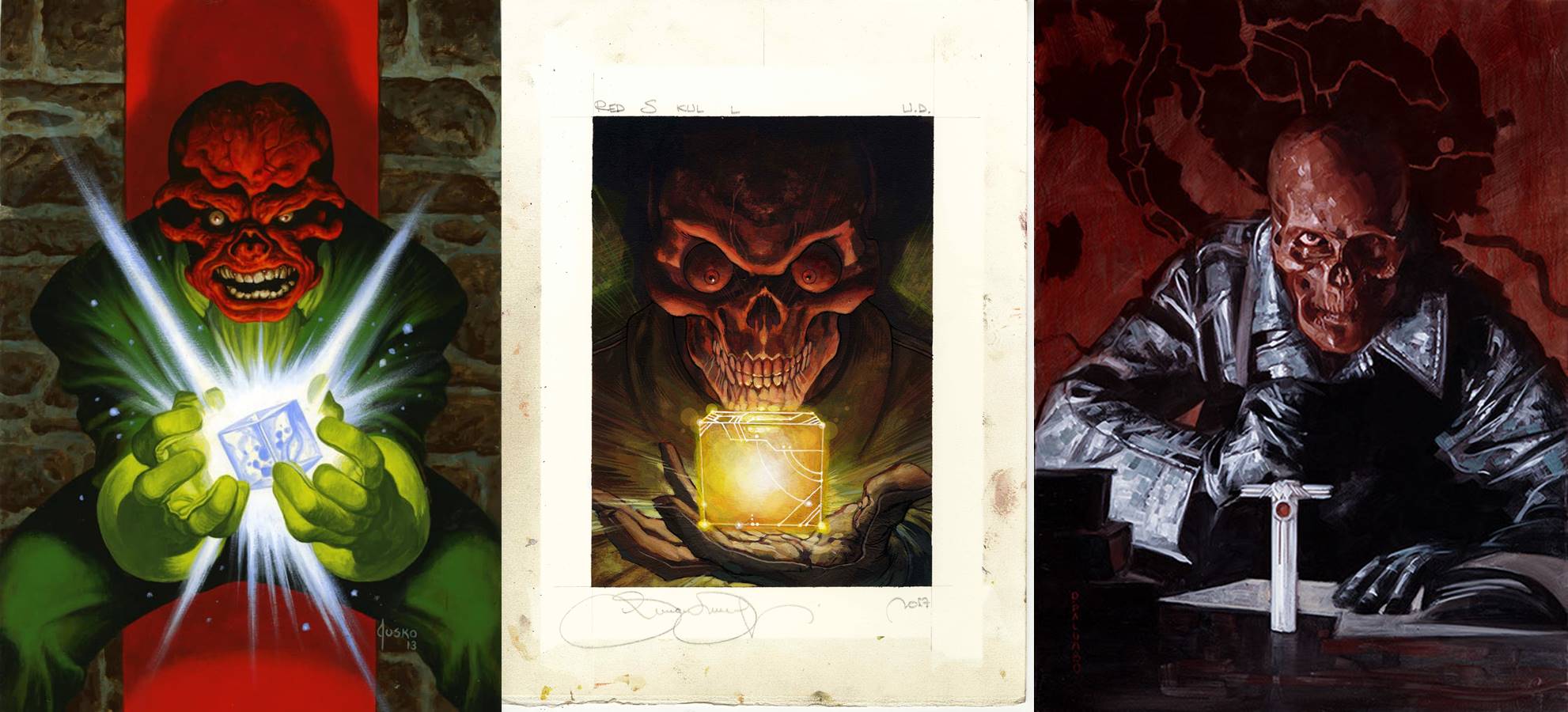
Left to right: Red Skull by Joe Jusko, 2016; Red Skull by Simone Bianchi, 2018; Red Skull by Dave Palumbo, 2020.
Red Skull is one of my favorite characters to collect sketches of, and we usually see him rendered in two ways: with or without the Cosmic Cube. The Cube, which was renamed the Tesseract for the MCU, is a central part of the early, WWII era conflicts featuring the former Nazi Red Skull and the First Avenger Captain America. His Nazi origins are not shown on any of these modern trading cards, though Jusko mentions in his book his original design included the swastika and red banner behind the characters head before he was required to remove it.
In both Jusko and Bianchi’s artwork, we see a hunched Red Skull coveting the Cosmic Cube, almost reminiscent of his stature on the cover of Captain America 103. Palumbo’s version adds a bit of realism, as we see the villain with sword stabbed into a table, and a wargames map behind his head, as if we’ve entered after a defeat and disturbed his preparation. Whether angry or ominous, the Red Skull has many different facets, and I hope to see them explored even further in future sets.
Ultron
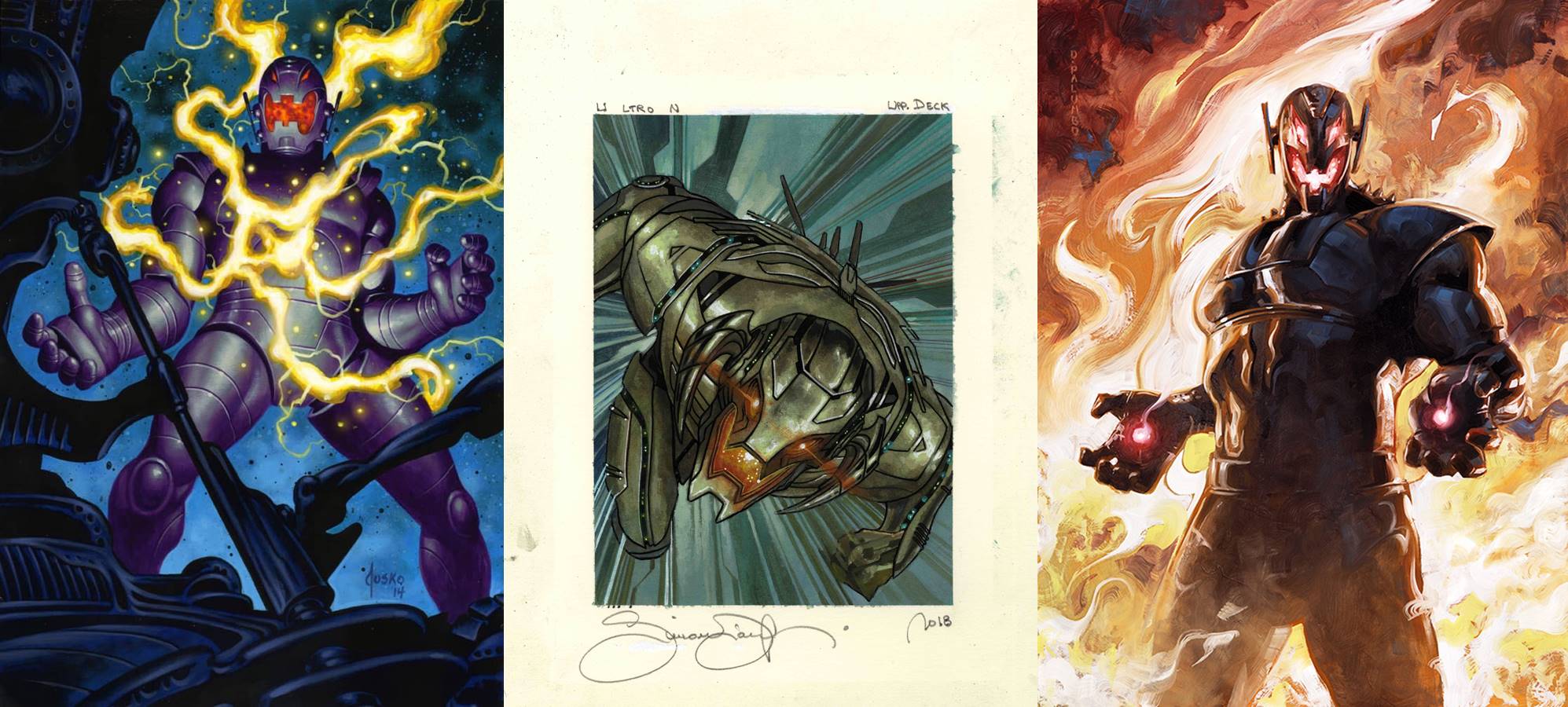
Left to right: Ultron by Joe Jusko, 2016; Ultron by Simone Bianchi, 2018; Ultron by Dave Palumbo, 2020.
I know I’m probably in the vast minority in that Age of Ultron is one of my favorite Marvel movies; but I absolutely love Spader’s Ultron, and all the cockiness, power and prose that was infused into the modern movie character.
In the world of trading cards we see those same traits echoed. Jusko’s Ultron crackles with power, a full body shot that emphasizes a molten maw and the raw strength of the character. Bianchi took a different approach, turning the character horizontal, setting him in motion, and focusing on a determined and decided evil robotic face. Palumbo’s Ultron is a bit of a blend of the two: Ultron is shown against a backdrop of fire and flame, his hands lit and ready to attack, seeming all powerful and all destructive. This was one of the first images released for the 2020 set, and when you add in the paintings’ soundtrack, it’s one of the signature works of the entire group that will be remembered for a long time as a quintessential version of the villain.
Thanos
Our only character for this article that has more than the standard one-per-year showing is the Mad Titan, Thanos.
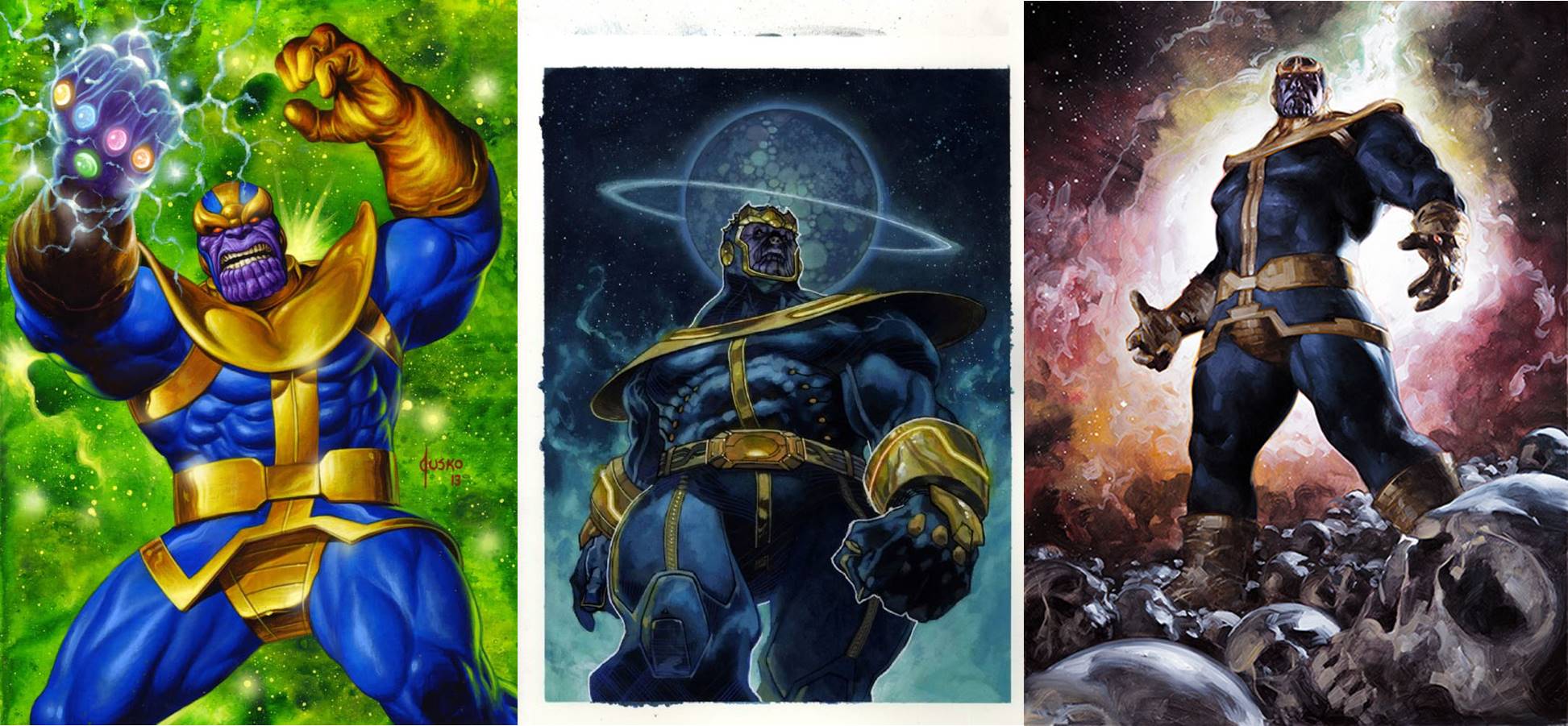
Left to Right Thanos (Base) by Joe Jusko, 2016; Thanos by Simone Bianchi, 2018; Thanos (Base) by Dave Palumbo, 2020.
Jusko’s Thanos is sent to space by way of liquid acrylic, which was moved around and marbleized to create the star pattern, and then the figure painted in afterwards. He made him as huge as possible without becoming comedic, and we see that carried into the next two renditions as well. A huge character in its own right, Bianchi’s Thanos is larger still, with an entire planet behind his head and an air of ultimate cosmic power derived from the juxtaposition. And Palumbo places the genocidal maniac atop a bed of skulls, with us as the viewer looking up to him, and against an extra terrestrial backdrop that removes him from time and space to reinforce his almighty power.
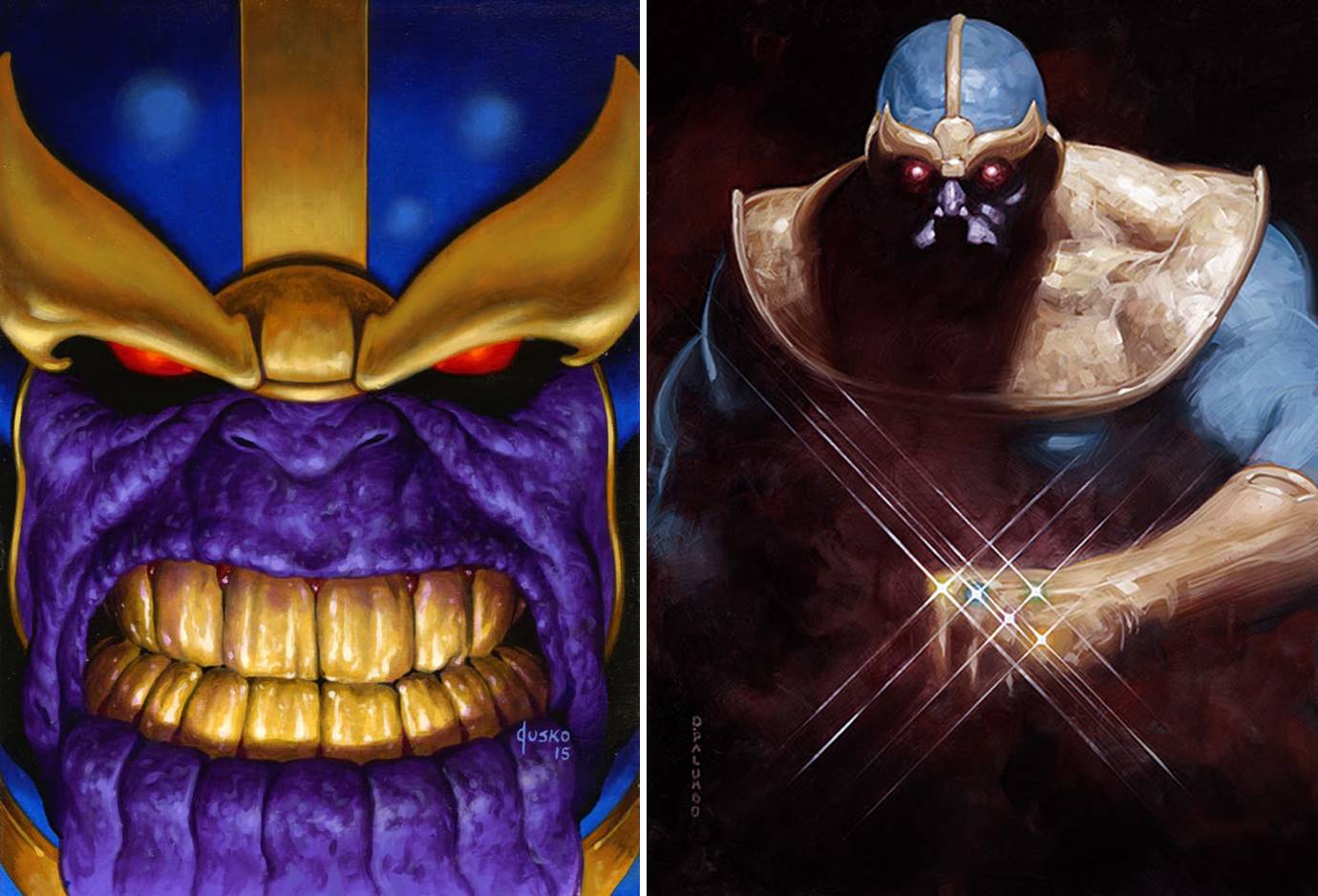
Left: Thanos (Canvas Gallery) by Joe Jusko, 2016. Right: Thanos (Canvas Gallery) by Dave Palumbo, 2020.
Thanos also holds a second card in the 2016 and 2020 sets, a Canvas Gallery card, where he is shown entirely differently than the Base Set iterations. In 2016, we got a super-zoomed shot of his face, showing all the nooks and crannies of his purple-hued face, chapstick-deprived lips, and yellowed teeth; I think these tight shots make for very cool cards in hand. Palumbo gives us a Gauntlet-bearing Thanos, with the Infinity Stones shining across the card and outside the frame, his eyes glowing in the dark right alongside the stones. This is another wholly unique take on the character, and looks especially fresh with the canvas matte card treatment.
Wrapping Up
These characters are the worst of the worst, the villains that have made some of our favorite characters into the heroes we’ve remembered for more than fifty years. For every similarity between the years there are distinct differences, the result of the artists building upon comic and cinematic influence, and a quest to represent the characters as distinctly by their hand. I enjoy looking at villains, and as we’ve seen, just because someone might be a bad guy doesn’t mean their artwork can’t be beautiful.
Our next edition of Parallels jumps over to a group led by someone who just made their debut back into the MCU; I’m not sure if you saw it or not, but if you understand that little hint, you’ll know who I’m talking about. And while we wait for that, don’t forget I’ll have the second Quarterly Report of the currently releasing Marvel Unbound set by fred.ian later this very month. You can keep up with all things Marvel Masterpieces 2020 by following me on Twitter. Feel free to ask questions or retweet to continue the conversation. Thanks and see you next time!
Donny Caltrider has been playing Magic since 2002 and collecting original Magic art since 2017. He has an M.A. in Museum Studies from Johns Hopkins University and enjoys telling stories about art, objects, and the intersection of fantasy with real-life. You can find him on Twitter talking about #mtgart, museums, and other #vorthos related goodness. Follow along and continue the conversation!

